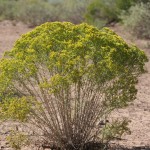Broom Snakeweed
Gutierrezia sarothrae (Pursh) Britt. & Rusby
Asteraceae (Sunflower Family)
Description
Broom Snakewood, a member of the Sunflower Family (Asteraceae), grows to resemble a bouquet spreading from the ground. It is a short-lived, perennial sub-shrub being very prolific and then dying back. It ranges from about 6 to 35 inches or 15 to 90 cm tall. Many unbranched, erect stems originate from a woody base forming a dense broom top and die back when the plant goes dormant. It is stouter and shorter than Common Broomweed with a brown stem below and green above, a deep taproot, and somewhat brittle branches. The simple, alternate, 2 to 6 cm leaves are narrow and threadlike with resinous glands that give a distinctive aroma when crushed leading to one common name, Turpentine Weed. While some green leaves may remain on the lower stems through winter, during droughts it can lose its leaves to conserve moisture. The small (3 to 10 mm) yellow flowers are clustered in 2 to 6 flower heads at the branch tips blooming from June to October. There are about 7 to 10 yellowish ray flowers surrounding a yellowish-orange disk. Thousands of these tiny yellow flowers form a large, rounded, terminal mass. Ricky Linex in Range Plants of North Central Texas states “The plant is not considered palatable, but livestock will sometimes eat early new growth in October and November, but more commonly choose it in late winter or early spring when other green forage is scarce.”Habitat
Broom Snakewood is widespread on dry ranges and deserts from California to Texas, south to Mexico, and north to Idaho. It tends to grow in shallow soils where over-grazing has reduced the grasses. Bowers and Tekiela in Wildflowers of Texas say it is “often the first plant to re-establish itself … following severe drought.” Extreme infestations reduce forage production but may not indicate overgrazed ranges because broomweed populations fluctuate naturally. However, overgrazing does accelerate the plant's growth and propagation.Toxic Agent
Broom Snakewood poisons cattle, sheep, goats, and swine. Some believe the toxic agent is steroidal saponin. The plant may accumulate selenium when on high selenium soil. Broom Snakewood is most toxic at earlier growth stages, usually in late winter or early spring, and on sandy soils. It is relatively nontoxic growing on clay soils. Cattle abort after eating as little as 20 pounds of fresh forage in 7 days. Cattle, sheep, and goats have been killed by eating 10 to 20 percent of their body weight in over 2 weeks. This plant appears not to cause any health problems to white-tailed deer and, in the case of pronghorn, it even supplies about one-third of their diet.Signs of Livestock Ingestion
Chronic poisoning signs include: Abortion; Stillbirth; Retained placenta; Weak offspring; Acute poisoning signs include: Periodic, thick nasal discharge; Crusting and sloughing of the skin of the muzzle; Listlessness; Loss of appetite and weight; Rough hair coat; Occasionally, dark brown or reddish urine; Frequent urination with diarrhea in the early stages changes to constipation with large amounts of mucous. Pregnant cows often have periodic vulvar swellings and premature udder development. George Clendenin in Common Rangeland Plants of West Central Texas states “Cattle, sheep, and goats have been killed by eating 10-20% of their body weight over a span of two weeks."Management Strategies
Do not graze gestating livestock on sandy soils during maximum Broom Snakewood growth (late winter and early spring). Proper range management practices that improve range conditions may help limit population densities and livestock consumption. Historically Broom Snakewood made up <5% of the biomass but on overgrazed sites, it can make up 50%. Carefully watch pregnant cattle grazing perennial Broom Snakewood-infested pastures. If udders develop prematurely, vulvas swell or abortions occur, move the herd to a Broom Snakewood-free pasture. Chemical control may be cost-effective when populations are dense enough to reduce forage production. Herbicide treatments include aerial or ground broadcast applications of Escort® at 0.0625 ounce a.i./acre in the spring when weeds are less than 4 inches high. Tordon 22K® may be used during and after the full flower stage in the fall at 0.25 to 0.5 pound a.i./acre. To reduce reinfestation, follow chemical treatments with proper range and livestock management programs.Images
Plant Characteristics
Flower Color: Yellow
Seed Type: Achene
Duration: Perennial
Stem Texture: Hairless/Smooth
Growth Habit: Forbs/Broadleaf
Leaf Shape
 : Simple with Pinnate or Parallel Venation
: Simple with Pinnate or Parallel Venation
Season: Warm
Distribution
 : 02 - Gulf Prairies and Marshes, 03 - Post Oak Savannah, 04 - Blackland Prairies, 05 - Cross Timbers and Prairies, 06 - South Texas Plains, 07 - Edwards Plateau, 08 - Rolling Plains, 09 - High Plains, 10 - Trans-Pecos
: 02 - Gulf Prairies and Marshes, 03 - Post Oak Savannah, 04 - Blackland Prairies, 05 - Cross Timbers and Prairies, 06 - South Texas Plains, 07 - Edwards Plateau, 08 - Rolling Plains, 09 - High Plains, 10 - Trans-Pecos
Distributions
Distribution refers to the ecological region in Texas that a plant has been found. You can also view a clickable map.
Book: Brush and Weeds of Texas Rangelands (B-6208), Toxic Plants of Texas (B-6105)
Collection: Brush and Weeds, Toxics, Wild Flowers
Livestock Affected: Cattle, Goats, Horses, Sheep
Livestock Signs: Abnormal Urination, Anorexia, Depression/ Weakness, Diarrhea, Loss Of Weight, Retained Placenta, Unthrifty Offspring






